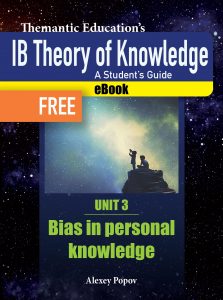This is the forth in a series of blog posts entitled “Traps and loopholes in the new TOK syllabus”. You can access the full list of blog posts in the series here.
Earlier I explored traps and opportunities linked to the “compulsory” knowledge framework in the new TOK spec. Now it’s time to switch over to another key addition in the new course – the themes. There are both traps and loopholes here as well. (For an overview of the new TOK spec, see The new TOK syllabus at a glance.)
Just a reminder: in the new course there is one compulsory theme (Knowledge and the knower) and five optional themes:
- Knowledge and technology
- Knowledge and language
- Knowledge and politics
- Knowledge and indigenous societies
- Knowledge and religion
Read more:
- Overview: Traps and loopholes in the new TOK syllabus
- Compulsory knowledge framework as a trap: artificial boundaries
- Compulsory knowledge framework as a trap: distribution of lesson time
- Compulsory knowledge framework as an opportunity: use key concepts and tick all the boxes
We must teach the compulsory theme and two out of five optional themes. In the IB-recommended course outline the three themes (one compulsory and two optional) are allocated 32 teaching hours in total, while areas of knowledge are allocated 50.
The rationale behind the addition of the themes is, and I quote the Guide, due to “...their contemporary real-world relevance and their rich potential to stimulate interesting and engaging TOK discussions...”
This is very nice and I fully support it. But let’s also look at assessments. Here are some points to consider:
- TOK essay titles will take the form of knowledge questions that are focused on the areas of knowledge. This means that by teaching the themes you are not directly preparing students for the essay.
- In terms of marks, the essay is twice as important as the exhibition (marks for the essay are doubled).
- The essay is externally assessed, which in some sense makes the essay a more important assessment component. It will be marked by an external examiner.
- If you follow the standard linear approach (first the themes, then areas of knowledge), then most of the teaching of areas of knowledge will be happening in the second half of your students’ IB course. That’s exactly when they are getting swamped by other things, such as internal assessments and the extended essays and multiple deadlines.
All these considerations combined make me think that if would be far more productive to start with areas of knowledge, or at least use an approach where the themes and the areas of knowledge are addressed simultaneously. I don’t want to leave areas of knowledge until the end, given how important they are in the assessment structure!
How can this be done? Read this blog post: “Themes as an opportunity: Teach areas of knowledge through themes and kill multiple birds with one stone” (coming soon)
However, if after reading this blog post you want to object that the exhibition is based on the themes therefore we need to start teaching with the themes, read this blog post: Themes as a trap: does the TOK exhibition have to be based on one of the themes?
Download a free preview of our TOK Textbook – “TOK: A Student’s Guide” – Download Free IB TOK Textbook Preview.

Alexey Popov is a teacher of IB Psychology and Theory of Knowledge. He is an IB author, examiner and workshop leader. He also authored Oxford IB Psychology books. He currently lives in Hong Kong.

